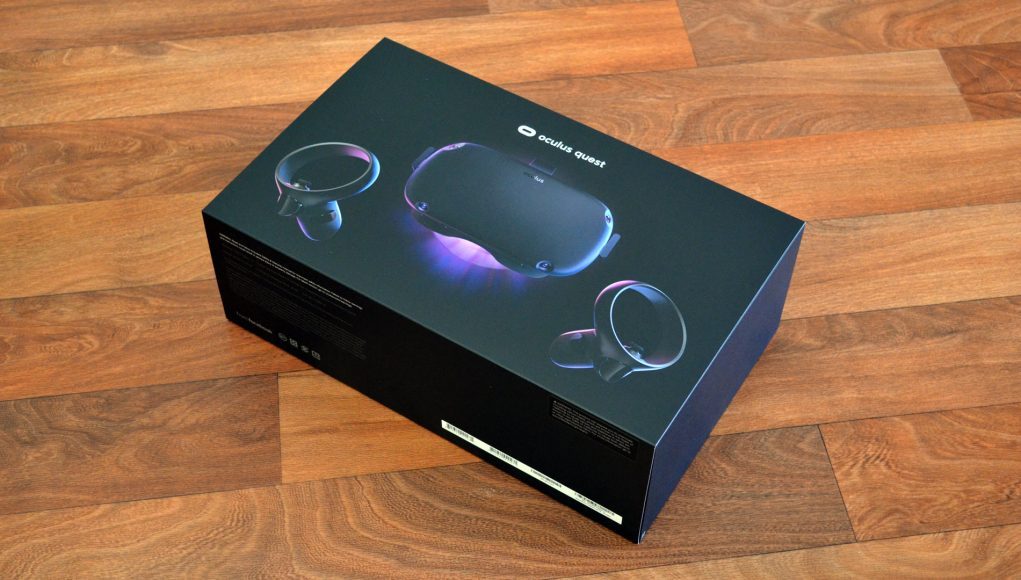After months of teasing, Oculus Quest starts shipping today. After testing the headset for several weeks, our Oculus Quest review is here. Because it doesn’t rely on a PC, but still has full tracking capabilities, Oculus hopes that Quest can bring VR’s most immersive experiences to a much wider crowd. Does Quest deliver? Read on to find out.
As usual, we’ll start with a review summary and then dig into the details further down.
Oculus Quest Review Summary
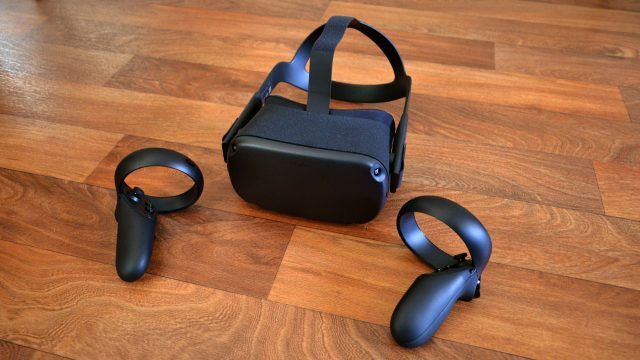
Oculus Quest is Facebook’s first standalone headset that offers 6DOF tracking on both the head and hands. Practically, that means that the headset has the same full tracking capabilities typically reserved for high-end VR headsets that are hooked up to a computer or game console. Because Quest has full 6DOF tracking, it opens the door to significantly more immersive and interactive content than on a headset like Oculus Go, which is only suitable for mostly static, seated experiences because it has more limited tracking abilities.
Given that it’s a standalone, Quest’s biggest advantage is its low friction experience. When you put the headset on, you see a pass-through video view of the world around you which makes it easy to pick up your controllers. From there, setting up your Guardian—the boundary around you playspace—is as easy as pointing your controller at the ground and tracing an outline around the available space, and then you’re good to go.
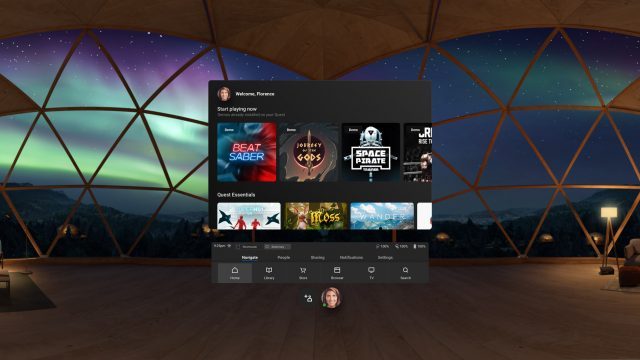
Quest’s menu is a bit clunky but functional, and feels snappy enough to not be annoying. From the menu you can search the Store for new games, access your Library to launch apps, and do other things like adjust settings, launch a web browser, and more. It’s a familiar experience for those who have used Oculus Go, as it’s largely the same interface.
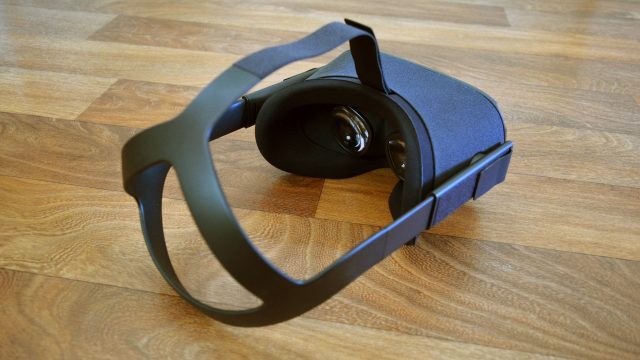
Visually speaking, Quest looks pretty similar to what you’d expect from an Oculus Rift, but with a bit more resolution (1,440 × 1,600 per-display vs. 1,080 × 1,200). That means slightly less screen door (the black space between pixels) and sub-pixels which are now just about invisible. The lenses have also seen an upgrade over the Rift, which somewhat reduces reflections in high contrast scenes. That said, the mobile processor in Quest simply can’t push the same quality image as a PC driven headset like the Rift, so in the end you’ll see improved clarity through Quest, but things just aren’t going to look as pretty in most cases—expect ‘mobile’ graphics.
That said, the visuals are more than adequate to provide compelling VR experiences. Some games look and play effectively identical to what you’d expect on PC. Beat Saber, for instance, looks nearly identical, runs smoothly, and feels great. This will be a little hit or miss with many of the ports that are initially launching on Quest, like Robo Recall, which has had much of its luster baked down into garish textures in order to get the game to run on the headset. Made-for-Quest games generally fare better graphically because they were designed for Quest’s graphical limits in the first place.
Quest’s inside-out tracking is perhaps the most important element because it’s the hardest thing to get right. In my time with Quest, I’ve been really impressed with the performance and robustness of the head and hand tracking—Quest is currently leading the industry here. Headtracking is extremely solid with very little latency, and the controller tracking is surprisingly performant, even when playing some of the most demanding games like Beat Saber.
There are two caveats to my praise of Quest’s tracking, although both are challenges faced by all inside-out tracking systems. Firstly, environmental factors can cause tracking issues. I was frankly quite surprised with how well Quest handled tracking in my apartment living room as well as it did. I have large windows around most of the room, and these look like massive bright lights during the day to Quest’s cameras—something that can be very confusing to computer-vision tracking. But still, things worked very well, and in hours of testing over many days I only saw the tracking drop out completely (the screen goes black and a message pops up until tracking is found again) a handful of times; in those times it was only for a second or two at a time. The controller tracking, on the other hand, would funk out briefly a little more often (perhaps due to passing in front of one of the bright windows), but it was infrequent enough that it really didn’t bug me.
The second caveat is that Quest does have some blind spots to its tracking, though in general they don’t cause trouble unless a game relies on a specific mechanic which frequently puts the controllers into the blind spots for extended periods. For instance, Creed: Rise to Glory asks you to hold your hands up in front of your face like you are blocking in a boxing match, and this would occasionally lead to the controller losing tracking for a few seconds at a time, which felt funky when one of my hands just stuck there in the air as I tried to throw a punch (before eventually popping back into the proper position).
So, edge-cases in both environmental factors and specific game gestures can trip things up, but on the whole Quest’s tracking works very well.
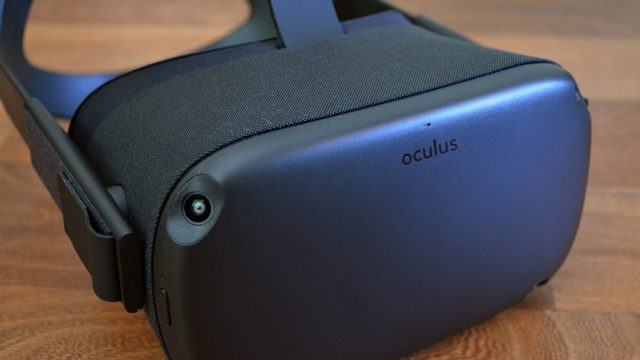
Quest effectively packs all of the features that make high-end VR great into an easier to use and more affordable package (everything but high-end graphics). And that gives the headset huge potential, so long as there’s great content to back it up.
Quest has a launch lineup of 50-ish titles, including probably the most important game that could be on the headset at launch—Beat Saber—and there’s a handful of other really strong entries, but the vast majority are ports and many of those are quite dated. Oculus will need to push hard to keep Quest’s library growing with quality (and genuinely new) content if they want to capitalize on its potential as an easy-to-use VR headset which has pretty much all the right stuff to deliver some really compelling experiences.
– – — – –
Oculus Quest In-depth Review
Hardware & Display
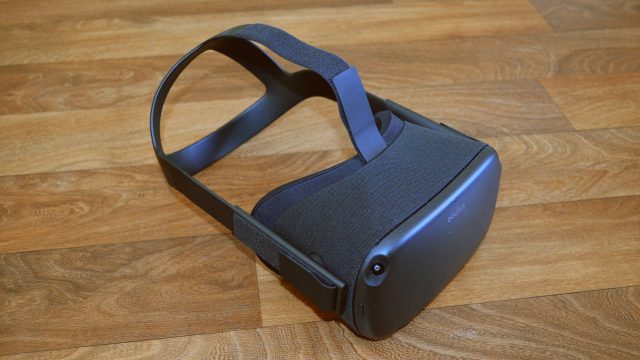
Quest is effectively a headset with a mid-range smartphone processor built inside. It’s running a Snapdragon 835 processor with active cooling, and the headset is offered with 64GB and 128GB memory options (unfortunately with no memory expansion ports).
Clearly visible on the outside of the headset are four cameras around the visor’s bezel which are used to track the headset’s movement via computer vision. The same cameras also see and track the controllers (which have invisible IR LEDs on them).
Very similar to Rift, Quest uses a pair of OLED displays, but with an upgraded resolution of 1,440 × 1,600 each (compared to 1,080 × 1,200). Quest also uses single Fresnel lenses, though Oculus says they’re improved over those used in the original Rift (and are in fact much closer, if not identical to the lenses used in Oculus Go). Quest has a field of view that’s almost identical to Rift, which we’d guess to be around 100 degrees diagonally (though Oculus won’t provide an official FOV figure).
If you’ve never used a VR headset before, Quests visuals are pretty good and there’s no serious complaints, save for the usual lens reflections (AKA god rays) and black smearing which are problems that every headset with Fresnel lenses and OLED displays runs up against. The field of view is wide enough that the world feels convincingly around you, and everything works well enough to easily make you forget which way you’re even facing in the real world (or even which room you’re in). If you have used another VR headset, I’ll make some comparisons to try to demonstrate what’s improved (or not).
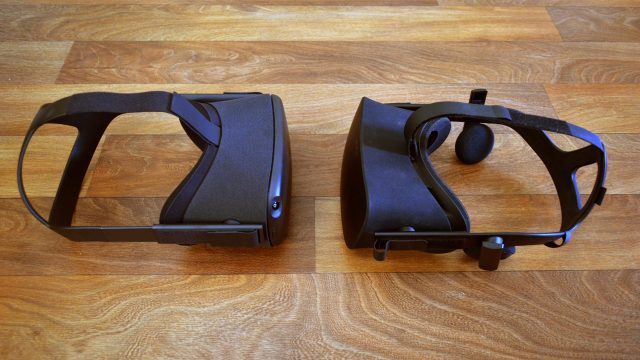
Quest offers a decent improvement in clarity over the Rift on a pure pixels-through-the-lens standpoint, but relative power difference means this may not mean quite as much except in a handful of cases where Quest is able to match the Rift pixel for pixel (like when playing back video or browsing the web). That said, the improved resolution directly translates to a sharper image, though this is tempered in many cases by the fact that the default render resolution for Quest is lower than its total resolution for performance reasons. The increased pixel density also means somewhat less screen door effect, and makes the sub-pixels just about invisible, making for more cohesive colors.
One of the biggest improvements from Rift to Quest is the mura, which on Rift was really not great, but on Quest looks all but eliminated. Mura is caused by inconsistencies in color and brightness from one pixel to the next, and usually shows itself mostly in darker scenes. Black smear (where dark areas bleed into bright areas during head movement) is still an issue (as it is for most OLED displays) and appears to be equally as bad as Rift.
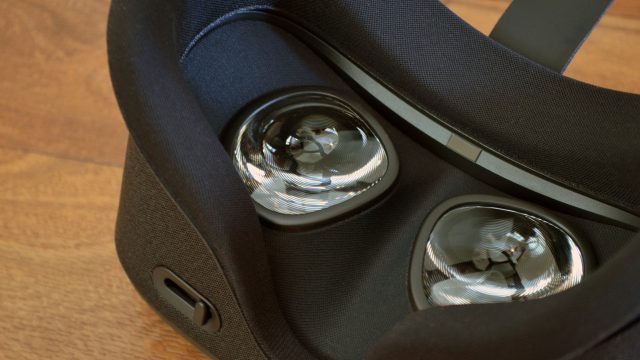
Quest’s lenses have seen an upgrade over the Rift, though it isn’t drastic. Internal reflections (AKA god rays) appear somewhat reduced, but are still annoying in high contrast scenes. The sweet spot also appears to be a little more favorable than the Rift, though it’s difficult to quantify this in a meaningful way.
Quest has a hardware IPD adjustment which means you can adjust the distance between the lenses to make sure your eyes are best aligned with the center of the lens (which is important for achieving maximum comfort and clarity). Oculus says that Quest’s IPD adjustment goes from 58–72mm, and is “best” for users with an IPD between 56mm and 74mm.
During setup, there’s an IPD calibration screen which shows a green cross which attempts to help users set their ideal IPD setting. Unfortunately there’s no digital readout of the IPD width inside the headset, so if you happen to know your IPD in millimeters, you can’t just dial it in based on the number. The green cross does a pretty awful job of making it clear which IPD setting is best. Unless this gets adjusted, I have a feeling many users are going to set their IPD wrong out of the gate, and may suffer reduced comfort because of it. This also means that if one user fiddles with it before handing the headset to another there’s no quick way to return to a known setting, which puts a slight damper on Quest’s potential for pass-and-play.
Tracking

Quest’s inside-out tracking is the best that I’ve ever seen in a standalone headset, and notably it’s the only headset in its class that offers fully-tracked controllers. Other consumer headsets like Oculus Go and the Lenovo Mirage Solo come with a single controller that only tracks rotation, putting a significant limit to how interesting and dynamic VR gameplay can be.
In my time with Quest, I’ve been really impressed with the performance and robustness of the head and hand tracking—Quest is currently leading the industry here. Headtracking is extremely solid with very little latency, and the controller tracking is surprisingly performant, even when playing some of the most demanding games like Beat Saber.
There are two caveats to my praise of Quest’s tracking, though both are challenges faced by all inside-out tracking systems. Firstly, environmental factors can cause tracking issues. I was frankly quite surprised with how well Quest handled tracking in my apartment living room as well as it did. I have large windows around most of the room, and to Quest’s cameras these look massive bright lights covering the walls during the day—something that can be very confusing to computer-vision tracking. Still, in hours of testing over many days, I only saw the tracking drop out completely—when the screen goes black and a message pops up until tracking is found again—a handful of times, and in those moments it was only for a second or two at a time. The controller tracking, on the other hand, would funk out briefly a little more often (perhaps due to passing in front of one of the bright windows), but it was infrequent enough that it wasn’t a problem most of the time.
It would be nice however if Oculus were to provide a few tips to new users about what kinds of things in their environment could be less than ideal for tracking. Big bright windows, mirrors, and moving objects (like ceiling fans) could pose problems, and it would be helpful if Oculus would tell users: ‘If you’re tracking is having issues, try doing XYZ to improve it’.
For instance, if I was trying to play Beat Saber and the controllers felt a little less reliable than I expected, I would rotate myself 45 degrees and use the recenter button to change my forward direction in the hopes of avoiding whatever in the room was bugging the tracking system. Most users probably aren’t going to really think about the ins-and-outs of the tracking system enough to know to try something like this, let alone to close problematic blinds, turn off ceiling fans, and avoid other computer vision foes.
The second caveat for tracking is that Quest does have some blind spots in terms of where the cameras can actually see the controllers, though in general they don’t cause trouble unless a game relies on a specific mechanic which frequently puts the controllers into the blind spots and keeps them there for several seconds at a time. For instance, Creed: Rise to Glory asks you to hold your hands up in front of your face like you are blocking a punch in real a boxing match, and this would occasionally lead to the controller losing tracking for a few seconds at a time; it felt funky when one of my hands just stuck there in the air as I tried to throw a punch (before eventually popping back into the proper position). Over time, developers will learn to avoid these blind spots when making their Quest-native games, but in the near term you might bump into them here and there.
So, edge-cases in both environment factors and specific game gestures can trip things up, but on the whole Quest’s tracking works very well.
Design & Ergonomics

Quest feels remarkably similar to the company’s first PC headset, the Oculus Rift. For those unfamiliar, that’s a compliment—the Rift is a well-built and designed headset that easily holds up three years after its initial launch. Like Rift, Quest feels like a solidly built device, and its fabric accents help it feel a little more human than a plastic box on your head. That said, it’s still a little bulky (as pretty much any VR headset is these days), and at 571 grams weighs in heavier than the Rift’s 470 grams.
Despite 100 grams of additional weight, I’ve found Quest to be at least as comfortable as the Rift. Quest has a larger and more flexible triangle opening in the rear straps which seems to find better purchase on the crown of my head than the Rift’s smaller and stiffer opening can manage. Slightly more generous foam also seems to help relieve pressure on the face.
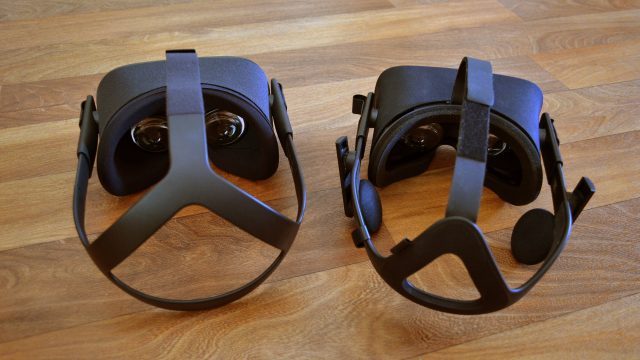
Just like with the Rift though, Quest can be very comfortable, but adjusting it as such is not intuitive for new users. Out of the gate, most people want to stick the headset on and then crank the side straps tight to create a vice-like grip between the visor and the rear straps; this feels like a good fit, but 15 minutes later your face won’t be very happy. The key is actually to find the place where the rear of the straps best grips the crown of your head, then use that grip as an anchor to adjust the top strap so that most of the visor’s weight is ‘hanging’ from the top strap. At that point, you want to tighten the side straps only as much as you need to in order to keep the headset stable on your face. This is far more comfortable for long-term play sessions.
Though Quest and Rift are quite similar in design, Quest drops the on-ear headphones in favor of some hidden sound holes in the headband. While this means more sound leakage (ie: other people can hear what’s going on in the headset) and arguably less immersive audio (because the sound is originating at the side of your ear instead of going straight into it), it does mean one less thing to fiddle with when you put the headset on.
The audio is acceptable and gets reasonably loud, though anything with deep bass has a chance of bottoming out. Luckily, you can use your own earbuds or headphones by plugging into either of the 3.5mm audio jacks on both sides of the headset. While Oculus is considering an official earbud accessory which would use both jacks, the company has confirmed that both are wired fully for stereo, so either side will work fine for any normal pair of stereo headphones.

Quest’s Touch controllers are a little different from Rift’s. For one, the tracking ring now goes over the top (to make it easier for the headset’s cameras to see), and the shape has been adjusted a bit too. To my hands, Quest’s controllers are ever so slightly less comfortable than the original Rift Touch controllers, but in the end they are equally functional and a very good controller design with a quality feel to every button and stick. Like the Rift controllers, Quest’s controllers use a single AA battery.

